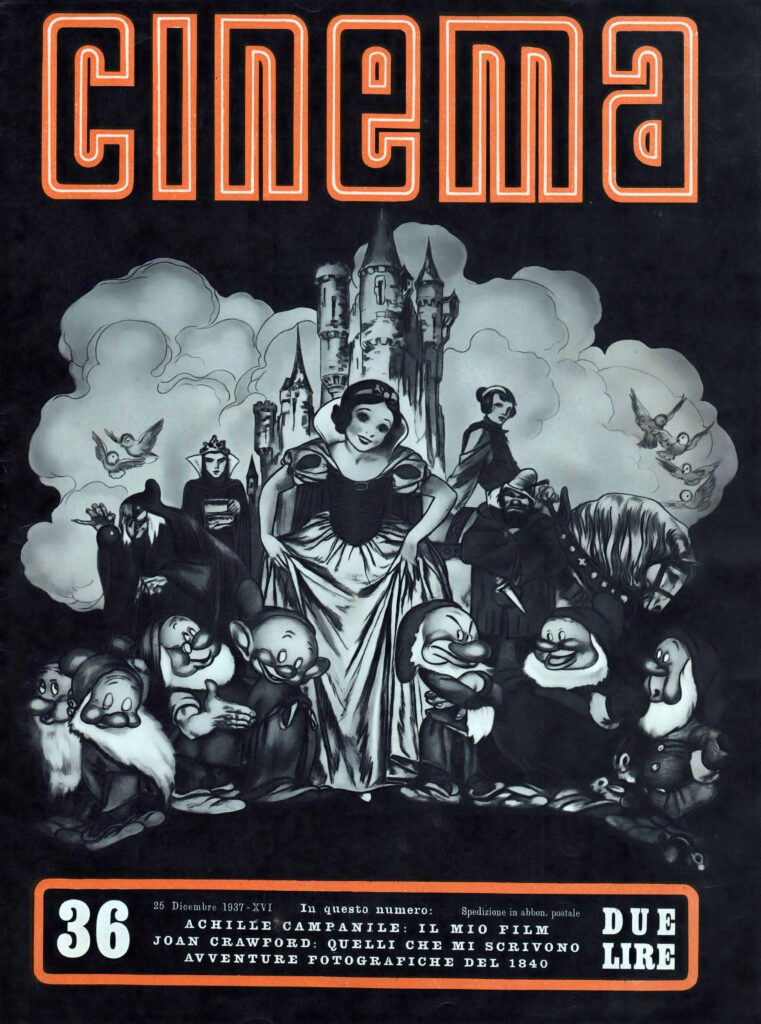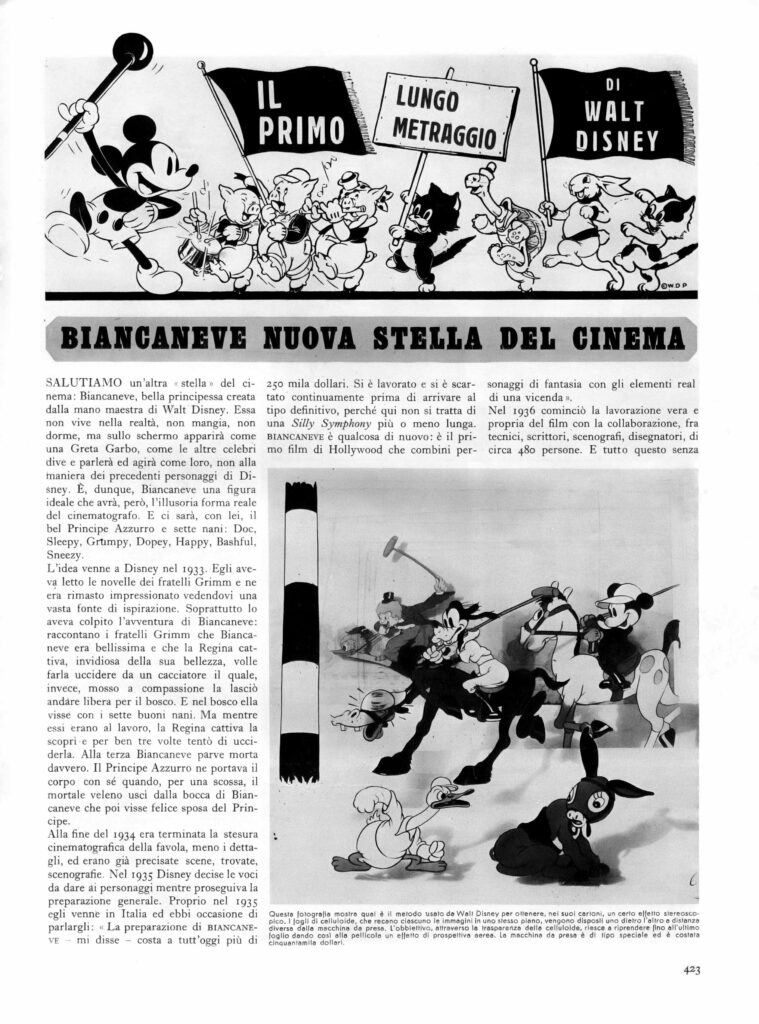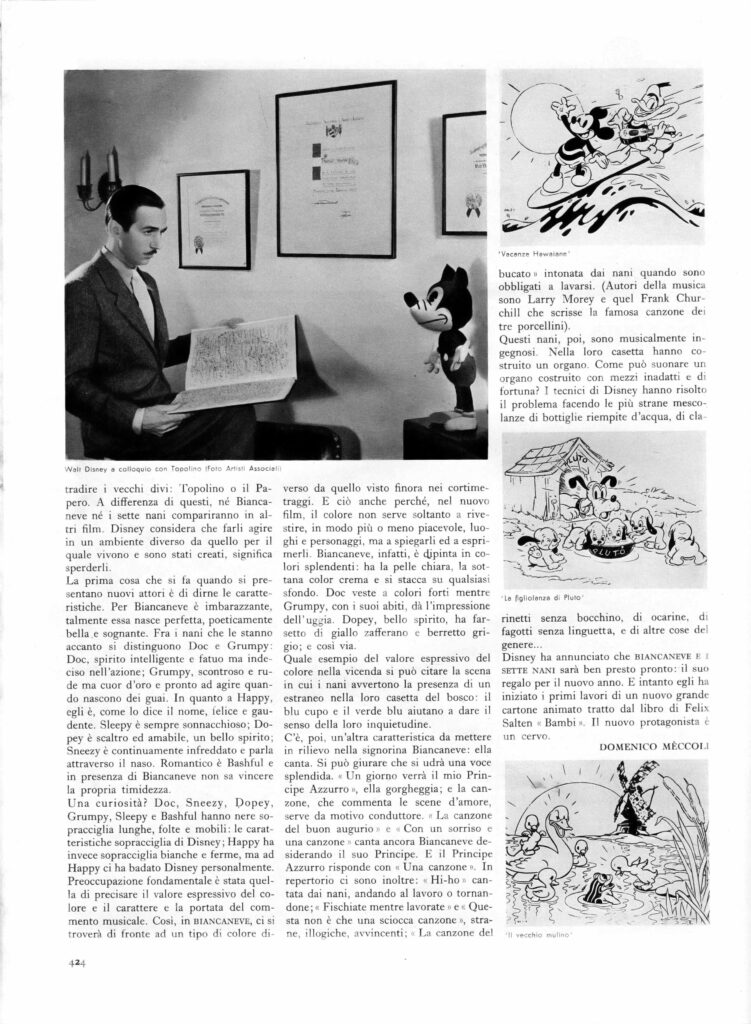Cinema was an Italian bi-mensual magazine published between 1936 and 1943, and again between 1948 and 1956.

December 25, 1937
The December 25, 1937 issue featured an article by Domenico Méccoli, which was in fact largely inspired by the article in the December 12, 1937 issue of Picturegoer. It also mentions the use of color, the voices and the characters, whose names have not yet been translated.
Above the article is a drawing with Mickey leading a parade made up of the three little pigs, kittens, Toby the tortoise and the hare. The latter carry banners and placards that form the phrase: “Walt Disney’s first feature film”. The article is then illustrated with images of Silly Symphonies, Mickey, Walt Disney… but not Snow White, to whom the article is entirely dedicated. But the cover makes up for this faux pas by stylistically reproducing a black-and-white version of Gustaf Tenggren‘s main illustration. Here’s the text translated in English, followed by the original Italian text.
Mommies’ new movie star
Let’s talk about another ” star ” of the cinema: Snow White, beautiful princess created by the master hand of Walt Disney. She does not live in reality, she does not eat, she does not sleep, but on the screen, she will appear like a Greta Garbo, like the other famous divas and she will speak and act like them, not in the manner of the previous Disney characters. She is, therefore, Snow White an ideal figure who will have, however, the illusory real form of the cinematograph. And there will be, with her, handsome Prince Charming and seven dwarfs: Doc, Sleepy, Grumpy, Dopey, Happy, Bashful, Sneezy.
The idea came to Disney in 1933. He had read the Grimm Brothers’ novellas and was impressed, seeing in them a vast source of inspiration. Above all, he had been struck by the adventure of Snow White: the Brothers Grimm relate that Snow White was beautiful and that the evil Queen, envious of her beauty, wanted to have her killed by a hunter who, instead, moved to, compassion let her go free through the woods. And in the woods, she lived with the seven good dwarfs. But while they were at work, the Evil Queen discovered her and three times tried to kill her. At the third Snow White seemed to be really dead. Prince Charming was carrying her body with him when, by a shock, the deadly poison came out of Snow White’s mouth who then lived happily married to the Prince.
By the end of 1934 the film writing of the fairy tale was finished, minus the details, and scenes, gimmicks, sets were already specified. In 1935 Disney decided on the voices to be given to the characters while general preparation continued. It was precisely in 1935 that he came to Italy and I had occasion to speak to him: ”The preparation of Snow White,” he told me, ”costs to date more than $250,000. It has been worked on and discarded continuously before arriving at the final type, because here we are not dealing with a long Silly Symphony. Snow White is something new: it is the first Hollywood film to combine fictional characters with the real elements of a story.”
In 1936 the actual making of the film began with the collaboration, among technicians, writers, set designers, and draughtsmen, of about 480 people. And all this without betraying the old stars: Mickey Mouse or the Duck. Unlike these, neither Snow White nor the seven dwarfs will appear in other films. Disney considers that to have them act in a different environment from the one for which they live and were created is to squander them.
The first thing one does when presenting new actors is to tell about their characteristics. For Snow White it is awkward, so perfect is she born, poetically beautiful and dreamy. Among the dwarfs beside her, Doc and Grumpy stand out: Doc, an intelligent and fatuous spirit but indecisive in action; Grumpy, grouchy and rough but a heart of gold and ready to act when trouble arises. As for Happy, he is, as his name implies, happy and jolly. Sleepy is always, sleepy; Dopey is sly and lovable, a fine spirit; Sneezy is continually cold and talks through his nose. Bashful is romantic and in Snow White’s presence cannot overcome his own shyness.
A curiosity? Doc, Sneezy, Dopey, Grumpy, Sleepy, and Bashful have black eyebrows that are long, thick, and mobile-the characteristic Disney eyebrows; Happy, on the other hand, has firm white eyebrows, but Happy was taken care of by Disney personally. Key concern was to specify the expressive value of color and the character and scope of the musical commentary. Thus, in Snow White, we will be confronted with a different kind of color than we have seen so far in the short films. And this is also because, in the new film, color serves not only to clothe, in a more or less pleasant way, places and characters, but to explain and express them. Snow White, in fact, is painted in bright colors: she has light skin, a cream-colored petticoat and stands out against any background. Doc dresses in strong colors while Grumpy, with his clothes, gives the impression of irritability. Dopey, beautiful spirit has a saffron yellow doublet and gray cap; and so on.
As an example of the expressive value of color in the story, one can cite the scene in which the dwarfs sense the presence of a stranger in their woodland cottage: the somber blue and blue-green help to give the sense of their uneasiness.
There is, then, another characteristic to highlight in Miss Snow White: she sings. One can swear that one will hear a splendid voice. ” Someday my Prince Will Come, ” she warbles; and the song, which comments on the love scenes, serves as a leading motif. ” I’m Wishing ” and ” With a Smile and a Song ” sings Snow White again longing for her Prince. And Prince Charming responds with ” One Song “. Also in the repertoire are ” Hi-ho ” sung by the dwarfs, going to work or returning from work; ” Whistle While You Work ” and ” A Silly Song, ” strange, illogical, compelling; ” The Washing Song ” sung by the dwarfs when they are obliged to wash. (Authors of the music are Larry Morey and that Frank Churchill who wrote the famous Three Little Pigs song.)
These dwarfs, then, are musically ingenious. In their little house they have built an organ. How can an organ built with inadequate and makeshift means play? Disney’s engineers solved the problem by making the strangest mixtures of water-filled bottles, clarinets without mouthpieces, ocarinas, bassoons without tabs, and other such things…
Disney has announced that Snow White and the Seven Dwarfs will soon be ready: his gift for the New Year. And meanwhile he has begun early work on a major new cartoon based on Felix Salten’s book “Bambi.” The new protagonist is a deer.
Domenico Méccoli
This photograph shows what is the method used by Walt Disney to obtain, in his cartoons, a certain stereoscopic effect. Celluloid sheets, each bearing the images in the same plane, are arranged one behind the other at different distances from the camera. The lens, through the celluloid’s transparencies, is able to shoot all the way to the last sheet, thus giving the film an effect of aerial perspective. the camera is of a special type and cost fifty thousand dollars.
Mamme nuova stella dei cinema
Saluiamo un’altra « stella » del cinema: Biancaneve, bella principessa creata dalla mano maestra di Walt Disney. Essa non vive nella realtà, non mangia, non dorme, ma sullo schermo apparirà come una Greta Garbo, come le altre celebri dive e parlerà ed agirà come loro, non alla maniera dei precedenti personaggi di Disney. È, dunque, Biancaneve una figura ideale che avrà, però, l’illusoria forma reale del cinematografo. E ci sarà, con lei, il bel Principe Azzurro e sette nani : Doc, Sleepy, Grumpy, Dopey, Happy, Bashful, Sneezy.
L’idea venne a Disney nel 1933. Egli aveva letto le novelle dei fratelli Grimm e ne era rimasto impressionato vedendovi una vasta fonte di ispirazione. Soprattutto lo aveva colpito l’avventura di Biancaneve: raccontano i fratelli Grimm che Biancaneve era bellissima e che la Regina cat¬tiva, invidiosa della sua bellezza, volle farla uccidere da un cacciatore il quale, invece, mosso a, compassione la lasciò andare libera per il bosco. E nel bosco ella visse con i sette buoni nani. Ma mentre essi erano al lavoro, la Regina cattiva la scoprì ‘ e per ben tre volte tentò di ucciderla. Alla terza Biancaneve parve morta davvero. Il Principe Azzurro ne portava il corpo con sé quando, per una scossa, il mortale veleno uscì dalla bocca di Biancaneve che poi visse felice sposa del Principe.
Alla fine del 1934 era terminata la stesura cinematografica della favola, meno i dettagli, ed erano già precisate scene, trovate, scenografie. Nel 1935 Disney decise le voci da dare ai personaggi mentre proseguiva la preparazione generale. Proprio nel 1935 egli venne in Italia ed ebbi occasione di parlargli: « La preparazione di BIANCANEVE — mi disse — costa a tutt’oggi più di 250 mila dollari. Si è lavorato e si è scartato• continuamente prima di arrivare al tipo definitivo, perché qui non si tratta di una Silly Symphony più o meno lunga. BIANCANEVE è qualcosa di nuovo: è il primo film di Hollywood che combini personaggi di fantasia con gli elementi real di una vicenda ».
Nel 1936 cominciò la lavorazione vera e propria del film con la collaborazione, fra tecnici, scrittori, scenografi, disegnatori, di circa 480 persone. E tutto questo senza tradire i vecchi divi : Topolino o il Papero. A differenza di questi, né Biancaneve né i sette nani compariranno in altri film. Disney considera che farli agire in un ambiente diverso da quello per il quale vivono e sono stati creati, significa sperderli.
La prima cosa che si fa quando si presentano nuovi attori è di dirne le caratteristiche. Per Biancaneve è imbarazzante, talmente essa nasce perfetta, poeticamente bella e sognante. Fra i nani che le stanno accanto si distinguono Doc e Grumpy: Doc, spirito intelligente e fatuo ma indeciso nell’azione; Grumpy, scontroso e rude ma cuor d’oro e pronto ad agire quando nascono dei guai. In quanto a Happy, egli è, come lo dice il nome, felice e gaudente. Sleepy è sempre, sonnacchioso; Dopey è scaltro ed amabile, un bello spirito; Sneezy è continuamente infreddato e parla attraverso il naso. Romantico è Bashful e in presenza di Biancaneve non sa vincere la propria timidezza.
Una curiosità? Doc, Sneezy, Dopey, Grumpy, Sleepy e Bashful hanno nere sopracciglia lunghe, folte e mobili: le caratteristiche sopracciglia di Disney; Happy ha invece sopracciglia bianche e ferme, ma ad Happy ci ha badato Disney personalmente. Preoccupazione fondamentale è stata quella di precisare il valore espressivo del colore e il carattere e la portata del commento musicale. Così, in BIANCANEVE, ci si troverà di fronte ad un tipo di colore diverso da quello visto finora nei cortimetraggi. E ciò anche perché, nel nuovo film, il colore non serve soltanto a rivestire, in modo più o meno piacevole, luoghi e personaggi, ma a spiegarli ed a esprimerli. Biancaneve, infatti, è dipinta in colori splendenti: ha la pelle chiara, la sottana color crema e si stacca su qualsiasi sfondo. Doc veste a colori forti mentre Grumpy, con i suoi abiti, dà l’impressione dell’uggia. Dopey, bello spirito, ha farsetto di giallo zafferano e berretto grigio; e così via.
Quale esempio del valore espressivo del colore nella vicenda si può citare la scena in cui i nani avvertono la presenza di un estraneo nella loro casetta del bosco : il blu cupo e il verde blu aiutano a dare il senso della loro inquietudine.
C’è, poi, un’altra caratteristica da mettere in rilievo nella signorina Biancaneve: ella canta. Si può giurare che si udrà una voce splendida. « Un giorno verrà il mio Principe Azzurro », ella gorgheggia; e la canzone, che commenta le scene d’amore, serve da motivo conduttore. « La canzone del buon augurio » e « Con un sorriso e una canzone » canta ancora Biancaneve desiderando il suo Principe. E il Principe Azzurro risponde con « Una canzone ». In repertorio ci sono inoltre: « Hi-ho » cantata dai nani, andando al lavoro o tornandone; « Fischiate mentre lavorate » e « Questa non è che una sciocca canzone », strane, illogiche, avvincenti; «La canzone del bucato » intonata dai nani quando sono obbligati a lavarsi. (Autori della musica sono Larry Morey e quel Frank Churchill che scrisse la famosa canzone dei tre porcellini).
Questi nani, poi, sono musicalmente ingegnosi. Nella loro casetta hanno costruito un organo. Come può suonare un organo costruito con mezzi inadatti e di fortuna? I tecnici di Disney hanno risolto il problema facendo le più strane mescolanze di bottiglie riempite d’acqua, di clarinetti senza bocchino, di ocarine, di fagotti senza linguetta, e di altre cose del genere…
Disney ha annunciato che BIANCANEVE E I SETTE NANI sarà ben presto pronto: il suo regalo per il nuovo anno. E intanto egli ha iniziato i primi lavori di un nuovo grande cartone animato tratto dal libro di Felix Salten « Bambi ». Il nuovo protagonista è un cervo.
Domenico Méccoli
Questa fotografia mostre qual è il metodo usato da Walt Disney per ottenere, nei suoi cartoni, un certo effetto stereoscopico. I fogli di celluloide, che recano ciascuno le immagini in uno stesso piano, vengono disposti uno dietro l’altro a distanza diversa dalla macchina da presa. L’obbiettivo, attraverso le trasparenza della celluloide, riesce a riprendere fino all’ultimo foglio dando così alla pellicola un effetto di prospettiva aerea. La macchina da prese è di tipo speciale ed è costata cinquantamila dollari.


